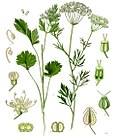Anise
(Redirected from Pimpinella anisum)
An overview of the spice anise, its uses, and properties
Anise (Pimpinella anisum), also known as aniseed, is a flowering plant in the family Apiaceae native to the eastern Mediterranean region and Southwest Asia. The flavor of anise resembles that of liquorice, fennel, and tarragon. It is widely cultivated and used to flavor food, candy, and alcoholic beverages, especially in the Mediterranean region.
Description
Anise is an annual herb growing to 1 meter (3 feet) or more in height. The leaves at the base of the plant are simple, 2–5 cm long and shallowly lobed, while the leaves higher on the stems are feathery pinnate, divided into numerous small leaflets. The flowers are white, approximately 3 mm in diameter, produced in dense umbels. The fruit is an oblong dry schizocarp, 3–5 mm long, usually called "aniseed".
History
Anise has been cultivated in Egypt since ancient times and was known to the Greeks and Romans. It was brought to Europe for its medicinal value and was used by the Romans in a spiced cake served at the end of feasts. Anise was also used in traditional medicine in the Middle East and India.
Culinary Uses
Anise is used to flavor a variety of dishes, from baked goods to savory meals. It is a key ingredient in Italian biscotti and German pfeffernüsse. Anise is also used in the production of alcoholic beverages such as ouzo, raki, anisette, and absinthe.
Medicinal Uses
Anise has been used in traditional medicine for its carminative, antiseptic, and antispasmodic properties. It is believed to aid digestion, relieve coughs, and act as a mild sedative. Anise oil is used in aromatherapy and as a flavoring agent in pharmaceuticals.
Cultivation
Anise is best grown in light, fertile, well-drained soil. It requires a warm, frost-free growing season of at least 120 days. The seeds are sown in spring, and the plant requires full sun to thrive. Anise is harvested when the seeds are fully ripe and have turned gray-brown.
Chemical Composition
The essential oil of anise contains anethole, which is responsible for its characteristic flavor and aroma. Other components include estragole, anisaldehyde, and anisketone. Anethole is also found in fennel and star anise, contributing to their similar flavors.
Also see
Transform your life with W8MD's budget GLP-1 injections from $125.
W8MD offers a medical weight loss program to lose weight in Philadelphia. Our physician-supervised medical weight loss provides:
- Most insurances accepted or discounted self-pay rates. We will obtain insurance prior authorizations if needed.
- Generic GLP1 weight loss injections from $125 for the starting dose.
- Also offer prescription weight loss medications including Phentermine, Qsymia, Diethylpropion, Contrave etc.
NYC weight loss doctor appointments
Start your NYC weight loss journey today at our NYC medical weight loss and Philadelphia medical weight loss clinics.
- Call 718-946-5500 to lose weight in NYC or for medical weight loss in Philadelphia 215-676-2334.
- Tags:NYC medical weight loss, Philadelphia lose weight Zepbound NYC, Budget GLP1 weight loss injections, Wegovy Philadelphia, Wegovy NYC, Philadelphia medical weight loss, Brookly weight loss and Wegovy NYC
|
WikiMD's Wellness Encyclopedia |
| Let Food Be Thy Medicine Medicine Thy Food - Hippocrates |
Medical Disclaimer: WikiMD is not a substitute for professional medical advice. The information on WikiMD is provided as an information resource only, may be incorrect, outdated or misleading, and is not to be used or relied on for any diagnostic or treatment purposes. Please consult your health care provider before making any healthcare decisions or for guidance about a specific medical condition. WikiMD expressly disclaims responsibility, and shall have no liability, for any damages, loss, injury, or liability whatsoever suffered as a result of your reliance on the information contained in this site. By visiting this site you agree to the foregoing terms and conditions, which may from time to time be changed or supplemented by WikiMD. If you do not agree to the foregoing terms and conditions, you should not enter or use this site. See full disclaimer.
Credits:Most images are courtesy of Wikimedia commons, and templates, categories Wikipedia, licensed under CC BY SA or similar.
Contributors: Kondreddy Naveen, Prab R. Tumpati, MD

